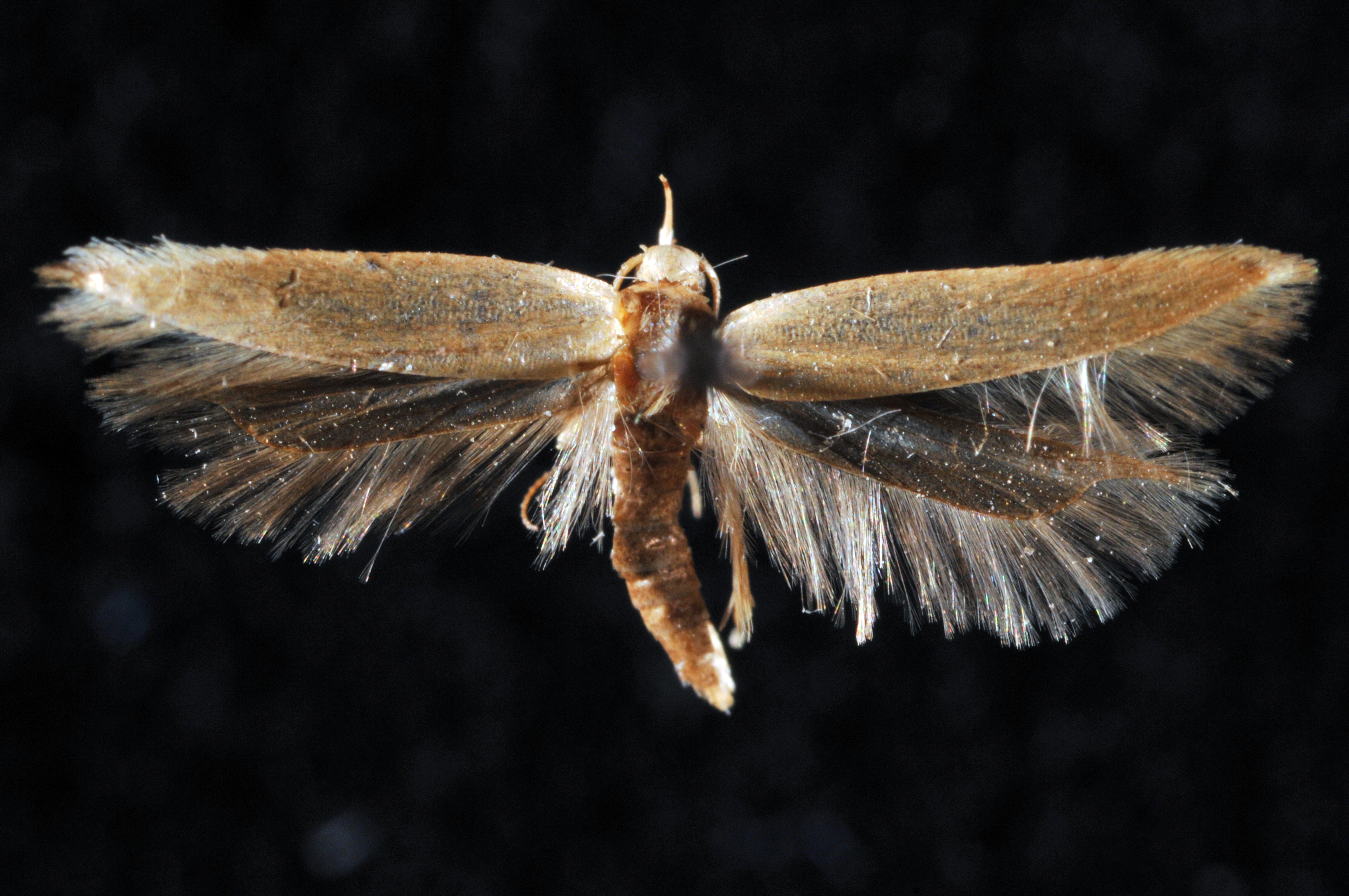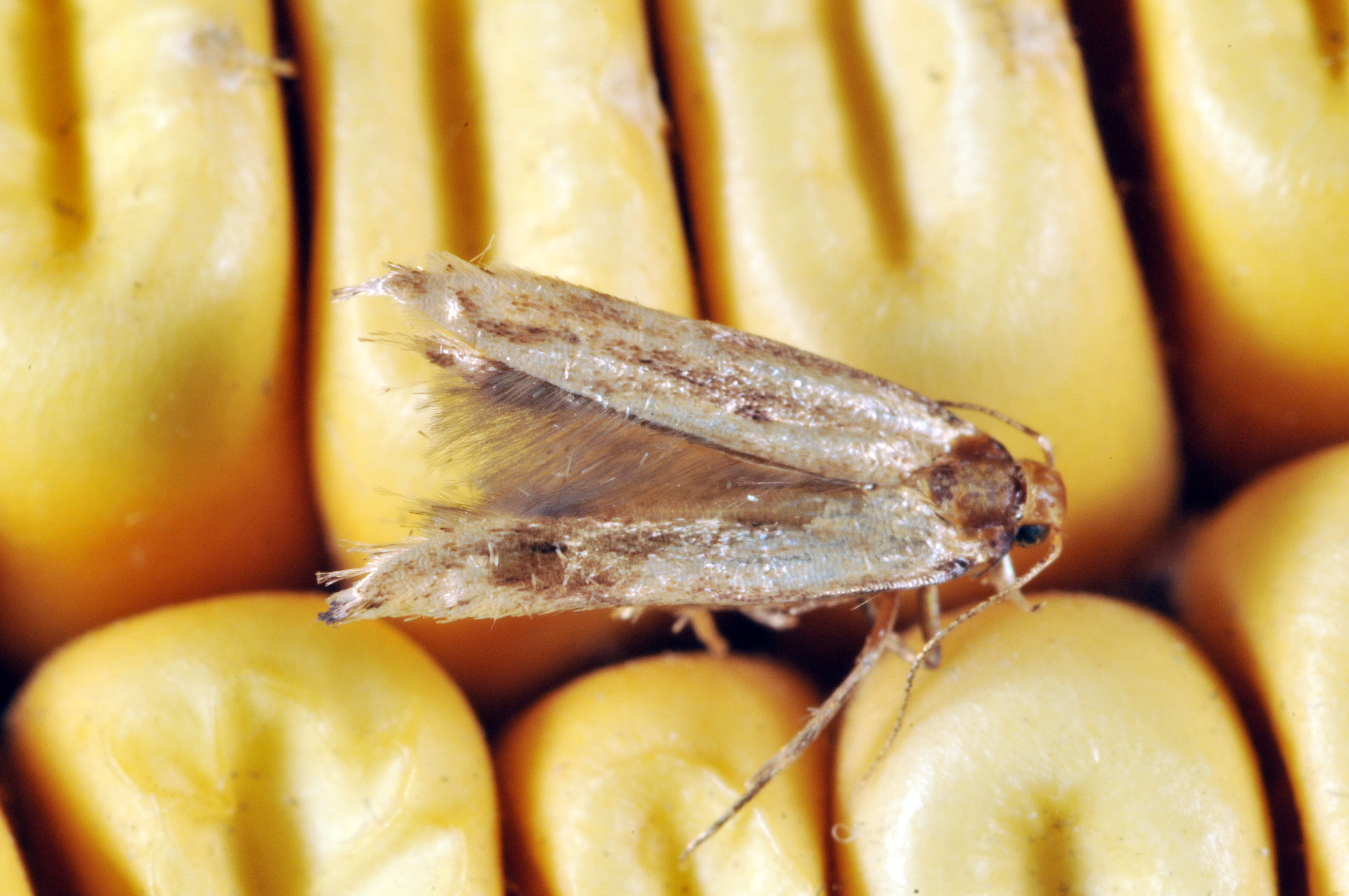Stored Product Pests
ANGOUMOIS GRAIN MOTH
Sitrotroga cerealella (Olivier)
Linda J. Mason, Extension Entomologist
If you want to view as pdf, click here
DESCRIPTION
Angoumois grain moth can be a pest of corn in the field and storage. It is sensitive to cold temperatures and not common in the northern United States. The wingspan is 1/2 inch. The forewings are clay-yellow and without markings; the hindwings are gray. The rear edges of the forewings and hindwings are fringed. Adults do not need to feed. Young larvae are white except for their head which is dark. Full-grown larvae are usually yellowish white with a yellowish brown head. Larval size may vary depending on sex, food, and environment. Five mm (1/8 inch) is about average larval size.
Angoumois grain moth. (Photo Credit: John Obermeyer)
Angoumois grain moth. (Photo Credit: John Obermeyer)
BIOLOGY AND BEHAVIOR
Eighty to 200 eggs are deposited on the outside of the kernel, grooves or holes made by other insects and the newly hatched larvae bore into the kernel. The larva remains inside the kernel until adult emergence. The number of eggs is dependent on food, season, or temperature. Two or three larvae may develop on a kernel of corn, but from other grains only one adult can be produced. There are three larval molts. The last larval instar usually spins a silken cocoon within the feeding cavity. The pupal case can be reddish brown to nearly black, depending on age.
Adults emerge through a small round hole in the kernel. Upon adult emergence, females move to a surface above the food to release the sex pheromone. Males are attracted to this pheromone for mating. Development time from egg to adult varies with temperature from 30 days at 30˚C (86˚F) and 40 days at 25˚C (77˚F). Minimum temperature/Rh for development is 16˚C (60.8˚F)/30% Rh; optimum is 30˚C (86˚F)/75% Rh and the maximum is 36˚C (95˚F). Adults are generally short lived (about 7 days) and are nonfeeding.
Like many moths the peak time for flight activity is dusk. Females alight on grain and are stimulated to oviposit. Air that has passed through the grain, especially grain that has some mold growth, acts as an attractant. Angoumois grain moth can coexist with sawtoothed grain beetle. However, maize weevil or lesser grain borers totally suppress Angoumois grain moth populations.
The larva is dormant for four to five months during the winter in colder climates. There are generally four to five generations per year, although in heated warehouses there may be as many as 10 to 12 generations.
FOOD
Angoumois grain moths can be found infesting a variety of grain and food materials. They attack all cereal grains, however are most often found in corn and wheat. It prefers damp grain in preference to old dry grain. It is the only storage pest that will attack standing grains in the field.
CONTROL
The only way to eliminate this pest is fumigation. Since it is an internal pest, residual control will only kill exposed adults. To kill the internal stages (larval & pupal), you must fumigate. Heating grain to 60˚C can kill larvae, however, this may decrease germination and baking quality of flour.
READ AND FOLLOW ALL LABEL INSTRUCTIONS. THIS INCLUDES DIRECTIONS FOR USE, PRECAUTIONARY STATEMENTS (HAZARDS TO HUMANS, DOMESTIC ANIMALS, AND ENDANGERED SPECIES), ENVIRONMENTAL HAZARDS, RATES OF APPLICATION, NUMBER OF APPLICATIONS, REENTRY INTERVALS, HARVEST RESTRICTIONS, STORAGE AND DISPOSAL, AND ANY SPECIFIC WARNINGS AND/OR PRECAUTIONS FOR SAFE HANDLING OF THE PESTICIDE.
November 2018

It is the policy of the Purdue University Cooperative Extension Service that all persons have equal opportunity and access to its educational programs, services, activities, and facilities without regard to race, religion, color, sex, age, national origin or ancestry, marital status, parental status, sexual orientation, disability or status as a veteran. Purdue University is an Affirmative Action institution. This material may be available in alternative formats.
This work is supported in part by Extension Implementation Grant 2017-70006-27140/ IND011460G4-1013877 from the USDA National Institute of Food and Agriculture.
1-888-EXT-INFO
www.extension.purdue.edu
Order or download materials from www.the-education-store.com




